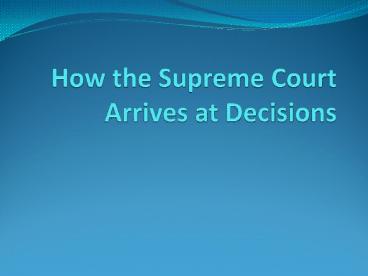How the Supreme Court Arrives at Decisions - PowerPoint PPT Presentation
1 / 10
Title:
How the Supreme Court Arrives at Decisions
Description:
The Supreme Court reviews between 150-170 cases (or around 6%) annually. Ultimately, for some cases, the court reaches a per curiam decision, ... – PowerPoint PPT presentation
Number of Views:262
Avg rating:3.0/5.0
Title: How the Supreme Court Arrives at Decisions
1
How the Supreme Court Arrives at Decisions
2
Answers Unclear
- While the words of the Constitution is binding,
the meaning of it is vague and left to the
Supreme Court for interpretation.
Society is Disturbed
The question of how to resolve problems often
produces a sharp division within the Court.
3
The Supreme Court Reviews Three Kinds of Cases
- Original Action Conflicts between states or
federal government. - Review of Decisions made by federal Court of
Appeals or federal District Court - - 11 federal Court of Appeals
- - 50 federal District Courts.
- Review of Decisions from a state court
- - If judgment rested on a federal question.
4
How the Supreme Court Reviews Each Case
- It doesnt.
- The Supreme Court reviews between 150-170 cases
(or around 6) annually. - Ultimately, for some cases, the court reaches a
per curiam decision, or a decision without
explanation.
5
Petition and Response
- -The most common way for the Court to put a case
on its docket is by issuing to a lower federal or
state court a writ of certiorari, or formal
document that calls up a case. - -Each application filed is a short petition with
markings from rulings of lower courts and federal
questions allegedly involved, argued their
sustainability, and whether they were properly
raised in lower courts.
6
Petition and Response
- Every Wednesday and Friday, the 9 justices meet
in conference. - It takes 5 justices to decide a case on merits,
but only 4 to put the case on their agenda. This
is known as the Rule of Four. - Only the justices attend these conferences.
7
Order of Seating
- Chief Justice begins discussion of each case.
Then the yields to the senior Associate Justice
and continues down the line. - Voting goes the opposite way beginning with the
junior Justice.
8
Each Side Gets an Hour
- -Oral argument occurs about 4 months after the
case has been chosen for review - - Sometimes, this time limit is cut in half.
- Counsels submit briefs 2 - 3 weeks before case is
heard a bench memorandum is usually prepared to
highlight background info and questions to ask of
case. - - 2 weeks of argument Monday to Thursday, then 2
weeks of recess for opinion writing and study of
petitions for review - - Argued cases are listed on the conference
agenda on Friday following argument - - Conference discussions and discussions of
centiorari petitions follow the same procedure
9
Opinions Assigned
- Some cases may take two or more conferences to
reach a decision. - - Discussion -gt vote -gt opinion in formal
writing - - Chief Justice assigns opinions in cases in
which he has voted with majority senior
Associate Justice voting with the majority
assigns opinions in others dissenters choose who
will write their opinions each Justice can
always include his/her argument. - - Writing takes weeks, maybe months, because of
additional research (laws, history, economics,
social and natural sciences). - - Copies of printed report are sent to all
Justices.
10
Some Change Minds
- The Justices review the printed report and make
comments, will wait until dissenters finish their
written argument - - Sometimes, dissenters change their votes -gt
could change majority -gt change final opinion































